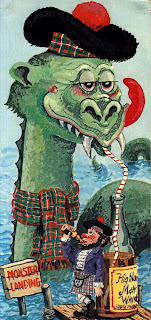Freaks of Nature, featuring an ajolote on its front cover (Dr Karl Shuker)
As a child in the late 1960s, I owned several of the animal editions in a series of tiny but fascinating books, each barely 3 inches long and containing just 32 pages, which were published by Bancroft and were aptly entitled 'Bancroft Tiddlers'. Sadly, most of mine are now long gone, having either fallen apart from over-enthusiastic use or been cut up for their pictures to paste in my numerous animal scrapbooks that I used to prepare with great zeal back in those far-distant days.
One 'Bancroft Tiddler' dealt with beetles (and I still own this today), others dealt with prehistoric animals, rare animals, tropical birds, etc. However, the one that I still recall most readily, #13 in the series, was entitled Freaks of Nature, and the reason why it made such an impression upon me was its front cover picture - which featured one of the most extraordinary creatures that I had ever seen.
As shown in this present ShukerNature blog post's opening illustration, the creature in question resembled a long, pink, segmented, coiled-up earthworm, except for its small but well-differentiated head (possessing a mouth and a pair of tiny dark eyes) – and, most dramatic of all, for the even smaller, single pair of clawed limbs visible just a little way back from its head, which looked rather like a pair of ears!
The ajolote spread from Freaks of Nature
This vermiform 'freak of nature' (which one might be forgiven nowadays for dismissing as an imaginative Photoshopped creation!) also appeared inside the book. There, it was revealed to be something called an ajolote, with the generic name Bipes (translating as 'two-footed'), which was a worm-lizard from Mexico. As can be seen from the above image, little else was said about it inside my 'Bancroft Tiddler', but it was enough to fire my interest and imagination, and stimulate me to seek out additional information concerning this astonishing little animal.
I discovered that the ajolote (of which there are four, very similar species, the best known being Bipes biporus, all approximately 6-9 inches long, confined exclusively to Mexico, and also known as mole lizards), was a very special type of amphisbaenian or worm-lizard. These latter reptiles are related to but taxonomically separate from both true lizards and snakes.
19th-Century sepia engraving of a limbless amphisbaenian
They are known as worm-lizards because superficially they do greatly resemble earthworms, both morphologically and behaviourally - spending much of their time in subterranean seclusion, moving via peristaltic locomotion, devouring real earthworms and other invertebrates, and often only emerging above-ground at night or when flushed out during heavy rain. Moreover, their tails are so similar in form to their heads that it is often difficult to decide which end of an amphisbaenian is which (their name is directly derived from the mythical amphisbaena - a worm-like monster with a head at each end of its body).
Amphisbaenians are native to tropical Africa, Morocco, the Middle East, southern Europe (Iberia and Anatolia), Florida, Mexico, the West Indies, and South America, and the vast majority are entirely limbless. The only exceptions are the four ajolote species, thanks to their tiny forelimbs.
19th-Century engraving of an ajolote (in the days when only a single species was recognised, and was referred to scientifically as Chirotes caniculatus)
Like other amphisbaenians, however, ajolotes are predominantly subterranean, fossorial species, feeding upon insects, worms, and very small lizards. They even breed underground, the female laying 1-4 eggs in July, which take 2 months to hatch. Sadly, however, ajolotes only live for 1-2 years.
Recently, I discovered online the eyecatching photograph below of an ajolote, and it seems evident that the drawing in Freaks of Nature was based upon it, but I have been unable to find any credit for this photograph, so any information regarding it would be greatly welcomed.
Online photograph of an ajolote (Photo owner unknown to me)
Interestingly, the ajolote has also cropped up as a possible identity in relation to two entirely separate creatures of cryptozoology – the European tatzelworm, and the Mongolian death worm.
One of the most tenaciously elusive mystery beasts has been reported for centuries from the Alps mountain range, extending through Switzerland, Austria, Italy, and Bavaria. It remains unknown to science, but is well known locally as the tatzelworm ('clawed worm'), stollenworm ('hole-dwelling worm'), or springworm ('jumping worm').
Tatzelworm model ((Markus Bühler)
Many eyewitness accounts of tatzelworms have been documented, some containing conflicting morphological details. Generally, however, this enigmatic beast can be described as follows.
Measuring 2-4 ft long, with light-coloured skin usually appearing smooth or surfaced with tiny scales, the tatzelworm is very elongate in shape, with a short and surprisingly cat-like head, a long worm-like body, and a blunt tail. Some observers claim that it has a pair of short clawed limbs at the front of its body; a few state that it also has a second, hind pair of limbs; and some allege that it has no limbs at all (although they may simply have been overlooked). It reputedly lives mainly in holes or burrows, but is sometimes encountered basking in alpine meadows on sunny days. If approached, it will usually vanish swiftly into its hole, but there are reports of decidedly belligerent tatzelworms that have leapt towards their startled eyewitnesses, usually causing them to flee rather than continue their observations!
Although the existence of such a sizeable creature still undiscovered by science in the Alps may seem unlikely to outsiders, the tatzelworm's reality to these mountains' inhabitants is such that in the 1800s it was even featured in three major alpine guides. According to one of them, Swiss naturalist Friedrich von Tschudi's Das Thierleben der Alpenwelt (1861):
"In the Bernese Oberland and the Jura the belief is widespread that there exists a sort of 'cave-worm' which is thick, 30 to 90 cm long, and has two short legs; it appears at the approach of storms after a long dry spell."
A tatzelworm drawing matching the above description had appeared 20 years earlier in a Swiss almanac, Alpenrosen.
The tatzelworm as depicted in Alpenrosen
However, perhaps the most famous tatzelworm illustration is the sketch of a 'scaly log' with a toothy grin, plus front and rear limbs, featuring in a Bavarian handbook, Neues Taschenbuch für Natur-, Forst- und Jagdfreunde auf das Jahr 1836, and based upon the description given by someone claiming to have shot one of these creatures.
The tatzelworm as depicted in the above-cited handbook
Over the years, some fascinating tatzelworm sightings have been recorded. One of the most dramatic, however, must surely have been the decidedly close encounter of the scary kind experienced one day in summer 1921 by a poacher and a herdsman while hunting on Austria's Hochfilzenalm Mountain, near Rauris. Suddenly, they became aware of a very strange animal, lying on a rock close by, watching them. Measuring 2-3 ft long, it was grey in colour, as thick as a human arm, with a feline, fist-sized head, and a thick tail. Alarmed, the poacher raised his rifle and shot at this bizarre beast - but as he did so, the creature, living up to its alternative name of 'springworm', abruptly jumped up through the air towards them, revealing two small front limbs but no rear limbs. Unsurprisingly, the men raced away.
A pallid smooth-skinned specimen measuring approximately 18 in long with two stub-like front limbs and noticeably large eyes was encountered in April 1929 by a teacher seeking the entrance to a cave on Austria's Mount Landsberg. The creature, which may have been a juvenile specimen in view of its small size, was lying in wet mouldy leaves, but swiftly vanished into a hole close by when the teacher tried to capture it.
Tatzelworm model (Markus Bühler)
Intriguingly, together with a number of snakes, an apparent tatzelworm was discovered in 1933 concealed inside a hollow space behind a stone wall being removed by some workmen at Spittal an der Drau in Austria. According to their description, it was 3 ft long, dirty white in colour with a yellowish tinge, and cylindrical in shape, with a cat-like head, big eyes, and two short front legs. The workmen gingerly manoeuvred this peculiar animal onto a shovel and, along with its serpentine companions, tossed it into the nearby Lieser river - across which it rapidly swam, until it disappeared from sight on the far-side bank.
Another noteworthy sighting took place near St Pankraz, Austria, in 1922, when a 12-year-old girl playing in a wooded area ran to see why her sister, playing close by, had suddenly begun to cry. When she reached her, the girl was terrified to spy, no more than 4 yards away, a grey-coloured creature with transverse grooves across its body, crawling between some stones. Measuring at least 1 ft long, it resembled a giant worm, but sported a pair of paws behind its head. Too shocked to move, the two sisters gazed at it in fascinated horror for a time before summoning up enough courage to run away.
A number of identities have been suggested in relation to the tatzelworm, including an unknown species of reduced-limbed lizard (several skinks, for instance, possess only a single pair of limbs), or even a legless lizard, as typified by the familiar slow worm Anguis fragilis and the larger European glass snake or scheltopusik Pseudopus apodus.
19th-Century colour engraving of a scheltopusik
As noted in my book The Beasts That Hide From Man (2003), however, by far the closest correspondence to the tatzelworm's reported morphology is provided by the ajolotes. Yet, frustratingly, these are unknown outside Mexico. However, there are several species of limbless amphisbaenian native to southern Europe. So is it conceivable that a large, highly elusive, undescribed species of two-legged, ajolote-lookalike amphisbaenian still awaits formal scientific discovery in central Europe?
The second cryptid that has been compared with the ajolote is a little-known mystery beast that I learnt about from veteran Mongolian death worm seeker Ivan Mackerle. Here is what I wrote about it in my extensive Fortean Studies paper (vol. 4, 1997) on the death worm that was later updated and republished as a chapter in my book The Beasts That Hide From Man (2003).
The Beasts That Hide From Man, depicting a reconstruction of the Mongolian death worm by Ivan Mackerle on its front cover (Dr Karl Shuker)
It was documented by Mongolian author S. Dzhambaldorzh in his book Mongol Nuucyn Chelchee ('Braid of Mongolian Secrets') (1990), which contains a section regarding the death worm, entitled 'The most interesting rare worm in the world'.
In that section, Dzhambaldorzh includes a report concerning an obscure cryptid that may or may not be one and the same as the death worm. Derived from geographer B. Avirmed of the Mongolian Geographical Institute, this report had first appeared in 1981, within a Mongolian newspaper. It featured the eyewitness testimony of a Mongolian shepherd:
"Shepherd L. Chorloo (Khorlaw) from Chongor Gobi in the south Gobi aimak (country) stated: "Here we see an interesting creature. Its body looks like salami, half of which is taken up by the head, and on the rear it has wings. I have seen it twice. On both occasions it was lying dead at the well."
Is it possible that this 'winged salami' is actually a worm-like reptile with only a single pair of legs, which, in a desert terrain, would probably be splayed or spatulate in shape for digging, and might therefore resemble wings? Needless to say, the ajolotes once again come readily to mind. Morphologically speaking, an extra-large ajolote would certainly provide a very plausible explanation for the legged/winged mystery worm of Chongor Gobi. Or at least it would if we are willing to assume that, because amphisbaenians' heads and tails are very similar in appearance - and because he had only ever seen dead specimens of his 'salami' cryptid - the shepherd may have mistakenly thought that his mystery beast's 'wings' (i.e. its spade-shaped legs) were at its body's rear end instead of its front end.
Photograph of a captive specimen of ajolote (at El Serpentario, La Paz, Baja California Sur, Mexico), showing one of its tiny forelegs (Marlin Harms/Wikipedia)
Even so, as ajolotes constitute an exclusively New World quartet, as with the tatzelworm this identification is zoogeographically unsatisfactory. Of course, as again noted earlier with the tatzelworm, it is conceivable that an Old World amphisbaenian lineage could have given rise to an undiscovered ajolote counterpart by convergent evolution. Yet aside from the account of the Chongor Gobi mystery beast, there is not a scrap of death worm related evidence to suggest this. Moreover, there is not even a single known species of amphisbaenian on record from the Far East anyway. Alternatively, the Chongor Gobi cryptid could be a species of two-legged lizard - of which a number of species are already known to science.
Yet regardless of its morphological similarity or otherwise to various species already known to science, it is still unclear whether or not this legged mystery beast from the Chongor Gobi is indeed one and the same as the seemingly limbless death worm reported elsewhere in the Gobi. Bearing in mind, however, that nomads prefer to keep as great a distance as feasible between themselves and any death worm that they encounter, it is not impossible that the latter cryptid really does possess a small, inconspicuous pair of limbs - but which can only be discerned if viewed at extremely close range or in dead specimens, and whose presence is therefore not widely realised, even among the nomads.
Finally: just in case you're wondering how I've been able to include photos here of both the cover and the ajolote spread from Freaks of Nature, bearing in mind that my childhood copy no longer exists, the answer is simple – a few days ago I was delighted to discover a copy for sale on ebay, so I duly bought it, for £2.50 plus p&p. And as you can see from the photo below of its front cover, to which its original price label was still affixed before I carefully removed it, book prices have certainly risen in the years since this little 'Bancroft Tiddler', first published in 1966 and written by Nicky Tulissio, was available in the shops! 2½p for a brand-new book! Those were the days!
Front cover of Freaks of Nature with its original price label still affixed (Dr Karl Shuker)































































